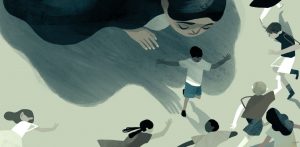The IAPSP International May Conference: “The Vulture in the Room”
 The IAPSP International May Conference titled “The Vulture in the Room,” took place on zoom on May 20th, 2023. Colleagues from Turkey co-hosted a case presentation offered by Mustafa Çevrim, followed by discussions from Şaziye Kazezoğlu, Petra Purkarthofer, and Jackie Gotthold. Arthur Gray moderated the meeting and Ceren Göker was the translator. The entire presentation was highly successful.
The IAPSP International May Conference titled “The Vulture in the Room,” took place on zoom on May 20th, 2023. Colleagues from Turkey co-hosted a case presentation offered by Mustafa Çevrim, followed by discussions from Şaziye Kazezoğlu, Petra Purkarthofer, and Jackie Gotthold. Arthur Gray moderated the meeting and Ceren Göker was the translator. The entire presentation was highly successful.
Mustafa’s patient, Eva, had received a doctoral level education, but had left academia and took an ordinary job after having a traumatic accident. The high expectations of her academic parents, and their highly critical, judgmental attitude proved challenging for Eva, not only during her development, but in the present. The metaphor used to describe the vulture-like presence of her parents in the room captures this aspect of her experience.
This fragile patient suffered attachment difficulties due to her childhood traumas, which included physical abuse and neglect. Nevertheless Eva made therapeutic progress connected with a therapist who had undergone similar experiences with his own academician parent. But a change in his supervisor during the therapeutic process disrupted Mustafa’s empathetic understanding of Eva, leading to a rupture in their connection, and evoking in Eva reactive responses of acting out, as Eva, experiencing the therapist as a vulture during these moments of rupture, reacted to this perception. However, Mustafa’s distinct approach in attempting to understand Eva as he regained his empathetic stance served to repair these ruptures. Despite the fact that Mustafa doesn’t explicitly share his subjective experiences of childhood traumas with Eva, he draws on this past experience to understand her. Indeed, these experiences of rupture and repair contributed to the progress of therapy, because the rupture and repair experiences led to the transmuting internalization of functions heretofore provided of the analysts contributing thereby to the development of new structures within the self.
The therapist and patient finding and interpreting self and nonself within their own subjective experiences in the intersubjective field has facilitated progress in and ultimately, completion of, the therapy process. Thus, working collaboratively on resolving the patient’s internal conflicts and addressing traumas has increased her functionality and positively impacted a change in her life.
In her discussion, Şaziye Kazezoğlu emphasizes her own subjective experience. She focuses on the earthquake in the southeastern part of Turkey two months prior to the presentation, causing the death of thousands, including loss of loved ones, and created homelessness. In a vertical dimension similar to the parent-child relationship, Şaziye underscores the similarity between the experience of leaders and the public. She narrates how, similar to the experience of a passive father witnessing the abusive mother, the passive father/leaders traumatize the public by being unable to intervene, akin to the earth swallowing several cities. She explains how the inadequacy of the selfobject functioning in the parent-child relationship, and the absence of empathy, created a traumatic experience for children. Emphasizing the importance of experiencing horizontal twinship to overcome this trauma, she compares it to the solidarity among siblings who have experienced trauma, highlighting the significance of civil society organizations coming to the aid of victims in the aftermath of natural disasters.
Petra Purkarthofer, at the beginning of her speech, mentioned that in Austria, legislation related to therapy education is being prepared, and attempts are being made to define professional competence boundaries. She highlights that, unlike the views of politicians, conducting psychotherapy education in university classrooms is not suitable, and it is essential for psychotherapy associations to express their views on this matter.
Petra pointed out the significance of the twinship metaphor in Mustafa’s therapy. She emphasized Mustafa’s efforts to empathetically understand the patient with his attention to the patient’s affective state, in this way validating the patient’s experience. When Mustafa makes interpretations that stray from empathetic understanding, there is a rupture in their connection. Working through this process allows the consideration of selfobject /intersubjectivity. Petra emphasized the mutual constitution of inner experience and intersubjective fields, noting that Mustafa and Eva share a twinship experience in trauma. Twinship involves being alike and being human, creating a bidirectional experience of finding oneself within the other, exploring both similarities and differences between them.
Jackie Gotthold emphasizes the significance of Mustafa’s and Eva’s work in terms of selfobject transferences and intersubjective systems theory, considering it a valuable example of exploring the often neglected twinship transference. She mentions that the presentation encompasses two distinct phases: the early stages, and the termination of therapy. The initial session provide insights into the positive trajectory of therapy.
As a young therapist, Mustafa initially felt hesitant about his patient’s experiences with him. However, he found relief from this uncertainty when he met Eva in the session. The therapeutic relationship became a leading edge for Eva, providing a sense of security and understanding, free from abandonment, and from emotional, physical, and sexual abuse in her new experience with him. Mustafa and Eva’s twinship in trauma served as a foundation of hope for her, enabling Mustafa to deeply understand her experience. Twinship transference facilitated mutual trust and profound understanding, fostering the development of a secret language between them similar to the non-verbal communication seen in twins. Despite occasional appearances of Eva’s vulture metaphor in sessions, Mustafa’s empathetic work makes it disappear. Through the expansive psychoanalytic experience, both Mustafa and Eva find liberation from their bonds.
After the case presentation and the words of the discussant, a rich communication emerged, with comments, questions, and contributions coming from the audience.
Sibel Mercan, MD

